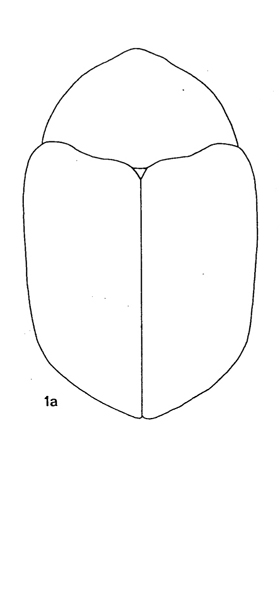 |
 Previous Genus Next Genus Previous Genus Next Genus 
Genus: Spinhyporhagus
Diagnostic Features
- Description: Body larger, convex, elongate-oval, size over 4 mm. Antennae 11-segmented with a 3-segmented club. Antennal setation sparse. Eyes well-developed, elongate-oval, somewhat reniform, coarsely faceted, extending well onto dorsal portion of head. Groove around dorsal edge of eye paralleling a narrow cuticular process directed away from eye for partial length. Lateral margins of pronotum arcuate. Pronotal disc simple. Hypomeron with deep antennal cavities. Antennal groove and cavity slightly curved (not recurved dorsally), ending before lateral margin of hypomeron. Antennal cavity concealed by prothoracic leg when retracted. Procoxal cavities open. Metacoxae widely separated, separation as wide or wider than metacoxal length. Scutellum small, triangular, visible. Abdominal ventrite 5 simple. Tarsal formula 5-5-4. Dorsal surface punctate, glabrous, shiny.
- Similar genera: The genus Spinhyporhagus is most similar to the other monommatine genera Aspathines and Hyporhagus. Spinhyporhagus can be separated from Aspathines by the larger size, 3-segmented anntennal club, antennal groove and cavity not strongly recurved dorsally and not ending near lateral margin of hypomeron, and antennal cavity concealed by the prothoracic leg when retracted. Spinhyporhagus can be separated from Hyporhagus and Aspathines by the presence of a thin cuticular process on the dorsal margin of the eye.
Known Distribution
Biology
- Members of the Monommatini are associated with rotting vegetable matter and are suspected to feed on fungus (Ivie, 2002).
- Abundance: known from only a single specimen.
North American Species (1)
Species Diagnoses
- Spinhyporhagus cuneispinatus: Southcentral species. This is the only member of the genus thought to occur in North America. The description and differentiation from similar genera above serve to distinguish this species from all other North American monommatines. Distribution: Texas, USA.
Discussion
- According to Ivie (2002), Freude (2000) described S. cuneispinatus from a single specimen labeled "Texas." No specimens of this species have been seen, and it is unclear whether or not the genus is established in the United States or if this species is valid. The only other described species of the genus, S. clavispinatus Freude, 1984, is known only from Brazil. No specimens of S. cuneispinatus have been seen, therefore, an image is not available at this time.
Potential Problems with Identification
- The nature of the head usually contracted within the pronotum will make this species difficult to separate from the genus Hyporhagus unless the head is removed.
Selected References
|
 |
 
Spinhyporhagus clavispinatus
from Freude, 1984
© N.P. Lord |
© 2011-2015 Lord, N.P., Nearns, E.H., and K.B. Miller
The University of New Mexico and Center for Plant Health Science and Technology, USDA, APHIS, PPQ.
|


